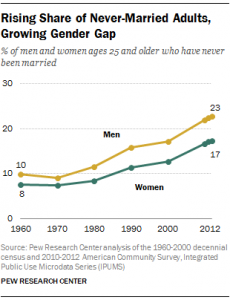Some economists and policymakers are currently discussing what they call the “family deficit”. The amount of married couples in America is on the decline, and is having varied economic impacts on varied groups. In 1960, only 12 percent of Americans aged 25 to 34 had never married. In 2010, 47 percent of Americans aged 25 to 34 had never married.
Social pressures regarding marriage have lessened since the 1960’s, with the lessening stigma of divorce and birth control becoming more accessible. Large amounts of women began to enter the workforce, those in unsuccessful relationships were able to leave and seek out new ones, and Americans on the whole began to have fewer children.
Marriage seems to be in decline, but is still more common with the middle/upper class than the lower class. Marriage, like going to college, might be becoming the “great class divide”. Many college-educated men and women have are still managing to get married. One of the most important aspects of marriage is its impact on the couples’ children. About 90% of university-educated women get married before having children. These women often marry university-educated men, and together provide a stable emotional and financial environment for their children. As for women who didn’t go to college, 58 percent of first-born children to are born out of wedlock. While half of unmarried mothers have a relationship with the father when the child is born, only 25 percent are still together five years later. Sawhill doesn’t think single parents cannot successfully raise a child, but she does believe that two parents are better than one: two paychecks, two guardians, and two listeners. On the contrary, 80 percent of married couples make it through their child’s first five years. Some argue poverty is the cause of single parents and unmarried couples, but Sawhill claims families in the 1950’s stayed together despite their low income and that a strong nuclear family is a solution to child poverty. Sawhill, when simulating the effect of having 1970 marriage rates in present day, saw child poverty drop 20%. Children born in the bottom quintile have an 83 percent chance of rising above the poverty line while living with married parents, but only a 50 percent chance if their parents never married.
Encouraging couples to marry before having children is tricky business. Tax incentives for married couples could increase the amount of committed relationships but could also punish and leave out single and/or childless adults. Higher employment would help single or unmarried parents avoid having to switch jobs and/or move locations. Safe and affordable childcare could lessen the stress for single parents. Many policymakers don’t seem to be considering the gradual legalization of same-sex marriage, which could bring an influx of successful married couples.
The family deficit could explain (and help address) some stubborn poverty issues, but it could be more related to the stresses of single parenting and the lower class having more children to care for relative to their incomes. To incentivize marriage could prove helpful in creating better environments for parents and their children, but could potentially ostracize middle and upper class single and childless Americans. With the rewarding of more “traditional” families, would we see a revival in “traditional” gender roles and values?

